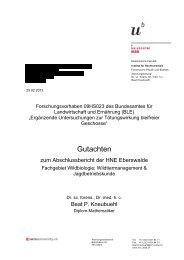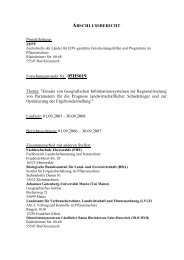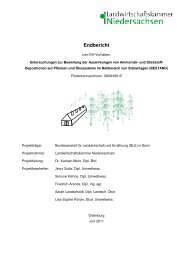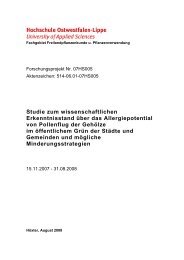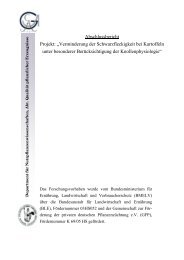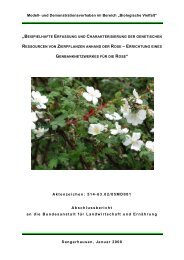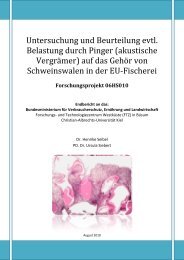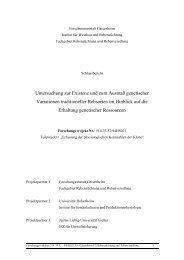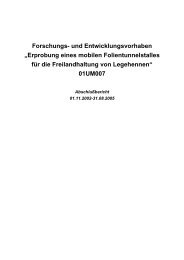Forschungs- und Entwicklungsvorhaben FKZ 01UM022/1 ... - BLE
Forschungs- und Entwicklungsvorhaben FKZ 01UM022/1 ... - BLE
Forschungs- und Entwicklungsvorhaben FKZ 01UM022/1 ... - BLE
Erfolgreiche ePaper selbst erstellen
Machen Sie aus Ihren PDF Publikationen ein blätterbares Flipbook mit unserer einzigartigen Google optimierten e-Paper Software.
FVH Az UM022/1 „Biol. Bekämpfung Apfelwickler“ Hopfenbauverein Immenstaad Abschlußbericht 52<br />
Die Prognose des Befallsrisikos durch Pheromonfallen ist aber aufgr<strong>und</strong> des punktuellen<br />
Auftretens dieses Schädlings sehr schwierig <strong>und</strong> risikoreich. Wird daher der Befall ignoriert,<br />
kann es jederzeit zu unvorhergesehenen Schäden kommen. Eine Lösung für dieses Problem<br />
könnte mittelfristig der Einsatz der Verwirrungstechnik auch gegen den Kleinen Fruchtwickler<br />
bzw. von kombinierten Dispensern, die sowohl die Pheromone für Apfelwickler als auch für<br />
Fruchtwickler enthalten, darstellen. Momentan ist dieses Verfahren jedoch in Deutschland<br />
noch nicht zugelassen.<br />
Unter den jetzigen Voraussetzungen scheint es daher sinnvoll, eine Behandlung mit<br />
synthetischen Insektiziden zum Zeitpunkt des Hauptschlupfes des Kleinen Fruchtwicklers in<br />
die Strategie zu integrieren. Dies könnte gleichzeitig einer Resistenzbildung des<br />
Apfelwicklers gegenüber CpGV entgegenwirken.<br />
Der Rückgang der Population des Fruchtschalenwicklers im untersuchten Gebiet muss nicht<br />
unbedingt nur auf die verfolgte Strategie zurückzuführen sein. Eine ähnliche Entwicklung war<br />
in der Region allgemein zu beobachten. Festgehalten werden kann jedoch eine sehr hohe<br />
Parasitierung der Sommergeneration im zweiten Projektjahr. Durch den anschließenden<br />
Zusammenbruch der Population konnte dies nicht weiter verfolgt werden<br />
Das Auftreten des Roten Knospenwicklers, der zu Projektende in vielen Anlagen gef<strong>und</strong>en<br />
wurde, sowie das des Kleinen Frostspanners <strong>und</strong> diverser Eulenraupen im Jahr 2005 muss<br />
bei einer künftigen Strategie berücksichtigt werden.<br />
6 Abstract<br />
Purpose of the project was the elaboration and implementation of a Codling moth control<br />
strategy combining biological methods such as mating disruption and codling moth<br />
granulovirus (CpGV) on larger areas. This strategy aims towards long-term population<br />
control on larger areas only.<br />
For the growers, it was important to reduce the use of synthetic pesticides. On the other<br />
hand, the risk of an unpredictable strong infestation, as observed very often in the area<br />
covered by the project, should be reduced.<br />
Thus, in this project not only the commercial orchards but also high apple trees (Streuobst)<br />
that normally remain untreated <strong>und</strong> extensive orchards were treated with CpGV to achieve a<br />
really area-wide reduction of Codling moth population. It was shown that the key strategy<br />
was the treatment of the high apple and pear trees three times a year with CpGV. Due to<br />
transport by wind these trees were even in more than 100 m distance from the commercial<br />
orchards important sources of infestation. The treatments had to be extended to high trees<br />
that were not considered at the beginning of the project because the distance to the<br />
commercial orchards was too high. Thus, in the project it lasted a rather long time until all<br />
sources of infestation were fo<strong>und</strong> and reduced.<br />
It could be shown that with three treatments of CpGV during the year the codling moth<br />
populations in the high trees could be reduced so much that they created no problems any<br />
more. However, this required an adequate application technique able to cover the high trees.<br />
The higher cost and effort for these treatments is balanced by a great reduction of the risk of<br />
a sudden unexpected Codling moth infestation as observed in the years before in these<br />
orchards. Since actually in Germany there are no pesticides that are highly effective against<br />
the second generation of codling moth, such a situation leads always to high economical<br />
losses for the grower.




